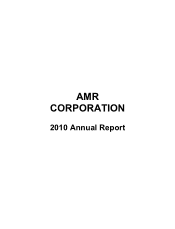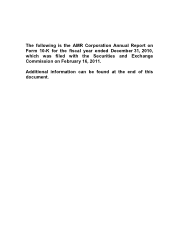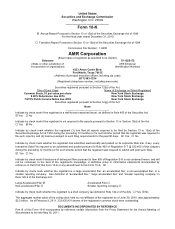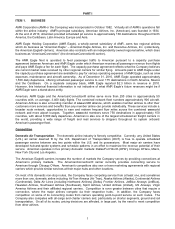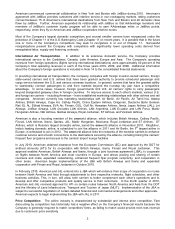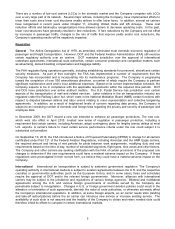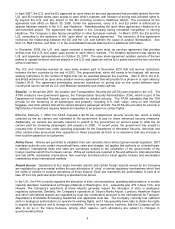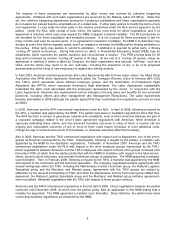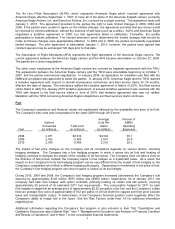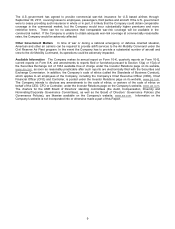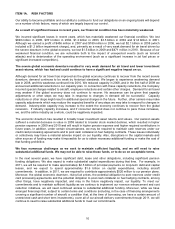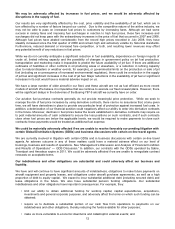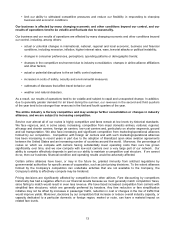American Airlines 2010 Annual Report Download - page 6
Download and view the complete annual report
Please find page 6 of the 2010 American Airlines annual report below. You can navigate through the pages in the report by either clicking on the pages listed below, or by using the keyword search tool below to find specific information within the annual report.
3
There are a number of low-cost carriers (LCCs) in the domestic market and the Company competes with LCCs
over a very large part of its network. Several major airlines, including the Company, have implemented efforts to
lower their costs since lower cost structures enable airlines to offer lower fares. In addition, several air carriers
have reorganized in recent years under Chapter 11, including United, Delta and US Airways. These cost
reduction efforts and bankruptcy reorganizations have allowed carriers to decrease operating costs. In the past,
lower cost structures have generally resulted in fare reductions. If fare reductions by the Company are not offset
by increases in passenger traffic, changes in the mix of traffic that improve yields and/or cost reductions, the
Company’s operating results will be negatively impacted.
Regulation
General The Airline Deregulation Act of 1978, as amended, eliminated most domestic economic regulation of
passenger and freight transportation. However, DOT and the Federal Aviation Administration (FAA) still exercise
certain regulatory authority over air carriers. DOT maintains jurisdiction over the approval of international
codeshare agreements, international route authorities, certain consumer protection and competition matters, such
as advertising, denied boarding compensation and baggage liability.
The FAA regulates flying operations generally, including establishing standards for personnel, aircraft and certain
security measures. As part of that oversight, the FAA has implemented a number of requirements that the
Company has incorporated and is incorporating into its maintenance programs. The Company is progressing
toward the completion of over 500 airworthiness directives, a number of which require the Company to perform
significant maintenance work and to incur additional expenses. Based on its current implementation schedule, the
Company expects to be in compliance with the applicable requirements within the required time periods. DOT
and DOJ have jurisdiction over airline antitrust matters. The U.S. Postal Service has jurisdiction over certain
aspects of the transportation of mail and related services. Labor relations in the air transportation industry are
regulated under the Railway Labor Act, which vests in the National Mediation Board (NMB) certain functions with
respect to disputes between airlines and labor unions relating to union representation and collective bargaining
agreements. In addition, as a result of heightened levels of concern regarding data privacy, the Company is
subject to an increasing number of domestic and foreign laws regarding the privacy and security of passenger and
employee data.
In December 2009, the DOT issued a new rule intended to enhance air passenger protections. The new rule,
which went into effect in April 2010, created new areas of regulation in passenger protection, including a
requirement that certain carriers, including American, adopt contingency plans for lengthy tarmac delays at most
U.S. airports. A carrier’s failure to meet certain service performance criteria under the rule could subject it to
substantial civil penalties.
On September 10, 2010, the FAA introduced a Notice of Proposed Rulemaking (NPRM) to change for all carriers
certificated under Part 121 of the Federal Aviation Regulations, including American and the AMR Eagle carriers,
the required amount and timing of rest periods for pilots between work assignments, modifying duty and rest
requirements based on the time of day, number of scheduled segments, flight types, time zones and other factors.
The Company and other carriers are seeking clarification with the FAA of certain provisions of the proposed rule
changes to determine if the new requirements could have a material adverse impact on the Company. If these
regulations were promulgated in their current form, we believe they could have a material adverse impact on the
Company.
International International air transportation is subject to extensive government regulation. The Company's
operating authority in international markets is subject to aviation agreements between the U.S. and the respective
countries or governmental authorities (such as the European Union), and in some cases, fares and schedules
require the approval of DOT and/or the relevant foreign governments. Moreover, alliances with international
carriers may be subject to the jurisdiction and regulations of various foreign agencies. Bilateral and multilateral
agreements among the U.S. and various foreign governments of countries served by the Company are
periodically subject to renegotiation. Changes in U.S. or foreign government aviation policies could result in the
alteration or termination of such agreements, diminish the value of route authorities, or otherwise adversely affect
the Company's international operations. In addition, at some foreign airports, an air carrier needs slots (landing
and take-off authorizations) before the air carrier can introduce new service or increase existing service. The
availability of such slots is not assured and the inability of the Company to obtain and retain needed slots could
therefore inhibit its efforts to compete in certain international markets.

